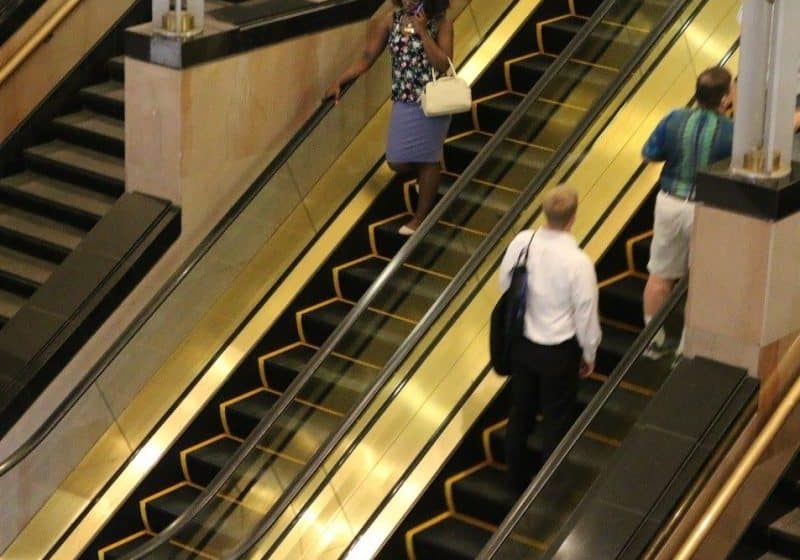Self regulation got the gears of standardization turning.
The June 19, 1910, issue of L’industria Rivista Tecnica ed Economica Illustrata featured the first in a 24-part series of illustrated articles titled “Apparecchi di Sollevamento e di Transporto: Gli Elevatori Industriali Considerati nei Riguardi della Sicurezza del Loro Esercizio” (“Lifting and Transportation Equipment: Industrial Elevator Use and Safety”). L’industria was a weekly magazine focused on industrial technology, safety and contemporary industry practices. The series was written by Luigi Pontiggia, director of the Associazione degli Industriali d’Italia per Prevenire gli Infortuni sul Lavoro, an organization founded in 1894 devoted to preventing workplace accidents. The perceived importance of elevator safety was such that the articles were republished in book form in 1911. Pontiggia’s editorial focus was the operation of elevators in industrial settings, a topic he introduced with an overview of contemporary elevator regulations. This brief survey constituted the first attempt to produce a comprehensive account and evaluation of European regulations governing elevator use. The book also provided the first overview of Italian elevator systems.
Pontiggia noted that elevator usage had steadily increased over the previous 20 years due to the needs of large industrial buildings and “modern high-rise buildings,” which had resulted in this technology being perceived as “an indispensable element of modern life.” This normative observation was followed by a more general observation that the emergence and use of new technology was often accompanied by accidents and that, over time, accidents often prompted the development of safety regulations.
Pontiggia made an interesting distinction between elevator use in industrial and nonindustrial buildings, with the latter defined as private and public buildings. He claimed that, while rules were necessary to ensure worker safety in industrial buildings, the presence of trained staff to oversee and maintain elevators eliminated the need for regular inspection or oversight by external agencies. He was confident that factory owners would recognize their “moral obligation” to maintain a safe workplace. However, he had a very different attitude about private- and public-building owners. He claimed that the typical owner’s “lack of competence” in purchasing equipment and the absence of qualified staff to maintain and service machinery offered compelling reasons that elevators in these settings should be subject to rules and regular inspection.
The distinction between industrial and nonindustrial elevator use and the imagined differences in safety was also reflected in Pontiggia’s attitudes toward these elevator user groups within Italy. One of his goals was to promote the creation of Italian elevator regulations predicated on best practices derived from European examples. And, he recognized that these regulations would require a means or system of enforcement, in which context he gave, perhaps, an overly optimistic benefit of the doubt to industrialists.
Pontiggia also cited the existence of a national attitude, which suggested that regulations were, in fact, unnecessary. Elevator accidents were characterized by some as an “inevitable consequence of the new means of transport” and were, thus, an acceptable price of progress. Pontiggia, not surprisingly, argued against this “fatalistic acquiescence.” He saw safety regulations, particularly as applied to nonindustrial settings, as means to protect “inexperienced customers” (i.e., non engineers) from accepting poorly designed or manufactured elevators for use in their buildings. Additionally, regular inspection of these elevators by trained experts was necessary, because, according to Pontiggia, their “maintenance is often entrusted to absolutely incompetent staff.” This distinction regarding elevator usage in diverse settings, the perceived need for regulation and the application of different safety rules to different settings was also reflected in contemporary European regulations.
Pontiggia began his examination with an investigation of elevator regulations in England. He reported that, prior to 1904, he had found “no rules that specified the safety precautions to be taken both in the plant and in the operation of the elevators.” He did, however, note that the Factory and Workshop Act of 1901 included one elevator safety regulation:
“Rule 10. Fencing of machinery. With respect to the fencing of machinery in a factory the following provisions shall have effect: (a.) Every hoist or teagle, and every fly-wheel directly connected with the steam or water or other mechanical power, whether in the engine-house or not, and every part of any water wheel or engine worked by any such power, must be securely fenced.”
While the placement of freight elevators in the category of “dangerous” moving machinery is, perhaps, logical, limiting the regulation to securing the hoistway ignores an obvious (and lengthy) list of other safety concerns. Pontiggia did note that “Rule 79: Power to make regulations for safety of persons employed in dangerous trades” gave the British Secretary of State the authority to establish new safety regulations (when needed):
“Where the secretary of state is satisfied that any manufacture, machinery, plant, process or description of manual labor, used in factories or workshops, is dangerous or injurious to health or dangerous to life or limb. . . the secretary of state may, subject to the provisions of this act, make such regulations as appear to him to be reasonably practicable and to meet the necessity of the case.”
However, no new elevator regulations had been implemented by 1910, the year Pontiggia began his study.
The British “rules” he referred to as having been established in 1904 were, in fact, recommendations contained in W. Sydney Smith’s Report on the Construction, Arrangement, and Fencing of Hoists and Teagles, published in 1904. The report had been commissioned in 1902 by Sir Arthur Whitelegge, chief inspector of factories, as a means of supplementing the limited guidelines found in the Factory and Workshop Act. Whitelegge had asked Smith “to prepare a report bringing out as far as possible the points in construction, arrangement, fencing and management which are necessary for the safety of workmen.” Smith’s investigation of this topic went far beyond “fencing” and included an examination of safety gears, locking grips for starting ropes and “other appliances.” In fact, the report constituted a comprehensive study of industrial elevator use in England. It concluded with a list of suggested regulations concerning hoists and teagles.
Although the term “teagle” had initially referred to all industrial elevator types, by 1900, it was defined as “a fixed lifting appliance in the form of a cathead, i.e., a derrick-pole, jib, or derrick. . . in combination with a winch by means of which goods are hoisted without the use of a cage or cradle, with or without the aid of mechanical power.” A “hoist” was defined as “an appliance for the conveyance of persons or goods by means of cages or cradles traveling in vertical or inclined shafts on fixed guides, with or without the aid of mechanical power.”
Smith’s recommendations for the “construction, fencing and working” of freight hoists addressed a broad range of topics:
- Stops should be provided on all hand ropes, starting ropes, rods or chains to stop the cage automatically at the highest and lowest points of travel, and all drum hoists should, in addition, be fitted with automatic stop motion to prevent overwinding.
- The maximum load that may be carried by any hoist should be clearly marked on the cage and on each landing.
- All hoist cages in which any person travels should be suspended by not less than two independent ropes or chains. (This, however, would not apply in the case of directly supported hydraulic ram hoists.)
- All ropes, cables and chains used for the suspension of hoist cages should be periodically examined, and chains and cables should be periodically examined and tested and also annealed at least once every 12 months. The safe loads indicated by the test and the times of annealing should be entered in a register kept on the premises.
- All projections in hoist wells, including door lintels, if the doors are not flush with the side of the hoist well, should be beveled by sloping boards, and the sides of all hoist wells should be made smooth.
- All hoist wells and landings should be efficiently lighted.
- A clearance of at least 3 ft. should be left at the top and bottom of the hoist well between the top and bottom of the cage, respectively, when the cage is at the points of its highest and lowest travel.
- The tops of all hoist cages should be covered with an efficient roof or with stout wire netting.
- Where cages are worked in an open hoistway, the cages should be securely fenced by doors or other efficient means to prevent persons or goods inside the cage from falling out.
- Except in cases where a competent person is appointed, whose sole duty is to attend to the hoist, the hoist openings should be securely fenced by efficient gates or doors, which should be automatic in action. In other cases, efficient locks or other secure fastenings on the well side of the door should be provided, and the keys placed in charge of a responsible person. The doors or gates should not be less than 6 ft. in height and should be so marked as not to be mistaken for ordinary doors.
- All hoist cages should be provided with efficient safety gears.
- Suitable locking grips should be provided for the hand starting ropes, rods or chains of all hoists where these pass through the cage.
- No person under the age of 18 years should work or be in charge of any hoist.”
Smith had developed these guidelines based on firsthand observations in factories and other industrial settings and through a limited examination of European elevator regulations. The report included summaries of German, French and Belgian regulations. In Germany, the regulations of the various trade associations require:
- Every hoist well within the factory building to be enclosed on every side.
- The entrances to the hoist on every landing to be provided with closing doors. In the rules of some associations, these doors must, as far as possible, close automatically, and be of such construction that they can be seen through and not mistaken for ordinary doors.
- Every hoist to be provided with signals to indicate when the hoist is in motion.
- Goods hoists to be provided with notices on each landing showing: ‘This hoist carries x cwt.’, ‘No entrance.’, ‘Not for persons.’
- Passenger hoists to be provided with a notice showing the maximum number of persons permitted.
- The use of each hoist to be as far as possible restricted to specified persons.
“In addition, the rules of the Linen Association prohibit young persons from entering the hoist unless in charge of the responsible attendant.”
In Belgium:
- Hoists, elevators, lifts, cranes and similar apparatus must be labeled with their power reckoned in kilograms, and, if used by the workpeople, with the number of persons they may carry with safety.
- The hoists, lifts and elevators must be controlled and arranged so that nothing can fall from them. The openings in the floors must be surrounded by a handrail, one of the sides of which (either in whole or in part) must be in the form of a movable barrier opening from the outside and closing automatically.”
In France:
- Hoists, lifts and elevators should be controlled and arranged so that the shaft of the lift and its counterbalance is closed, that the closing of the well at the landing place of the different floors takes place automatically, and that nothing can fall from the cage into the well.
- In the case of passenger hoists, the load must be calculated at one-third of that allowed for goods, and the hoists must be provided with brakes or other safety apparatus.”
The French and Belgian regulations appear to be translations of rules approved in 1894: “Décret du 10 Mars 1894 concernant l’hygiène et la sécurité des travailleurs dans les établissements industriels” (France) and “Arrêté Royal du 21 Septembre 1894 sur la salubrité intérieure des ateliers et la protection des ouvriers contre les accidents du travail” (Belgium). The origin of the German regulations is unknown.
Whitelegge hoped that Smith’s recommendations would “lead to material reduction in the serious number of preventable accidents due to these appliances in places under the Factory and Workshop Act.” While he anticipated that they would be adopted voluntarily, he stated in the report’s introduction, “Failing this, it may be necessary to consider the institution of regulations under Section 79 of the Factory and Workshop Act.”
Pontiggia published all of Smith’s recommended regulations in his book, and, as noted above, reported that none of them had been officially adopted under British law. Whitelegge’s hope that responsible factory owners would voluntarily adopt reasonable safety regulations paralleled Pontiggia’s belief that industrialists could be trusted to take care of their workers. Of course, missing from Whitelegge’s and Smith’s work was any reference to passenger elevator safety in nonindustrial buildings — a topic not addressed in the Factory and Workshop Act. Pontiggia also made no reference to English regulations regarding passenger elevators. This absence reflected the fact that, in 1910, there were no national British safety regulations for passenger elevators used in nonindustrial settings. The absence of detailed passenger elevator regulations was not unique to England, and, as will be seen in Part Two of this article, was common throughout most of Europe.
Get more of Elevator World. Sign up for our free e-newsletter.









